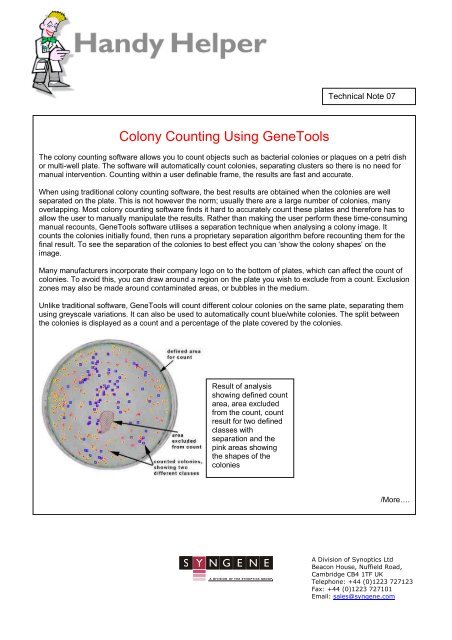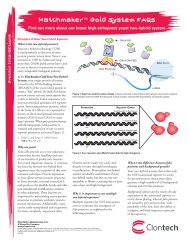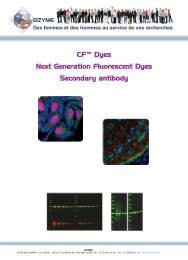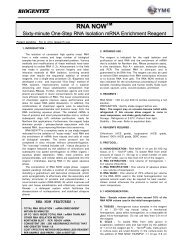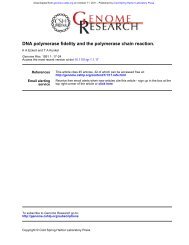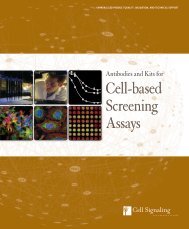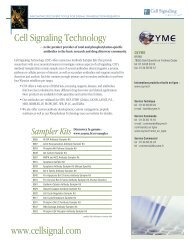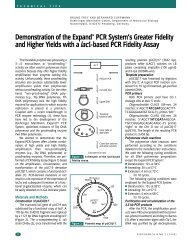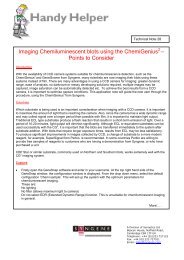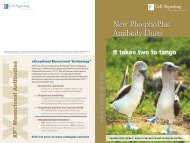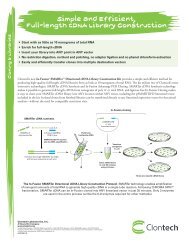Colony Counting Using GeneTools - Ozyme
Colony Counting Using GeneTools - Ozyme
Colony Counting Using GeneTools - Ozyme
You also want an ePaper? Increase the reach of your titles
YUMPU automatically turns print PDFs into web optimized ePapers that Google loves.
Technical Note 07<br />
<strong>Colony</strong> <strong>Counting</strong> <strong>Using</strong> <strong>GeneTools</strong><br />
The colony counting software allows you to count objects such as bacterial colonies or plaques on a petri dish<br />
or multi-well plate. The software will automatically count colonies, separating clusters so there is no need for<br />
manual intervention. <strong>Counting</strong> within a user definable frame, the results are fast and accurate.<br />
When using traditional colony counting software, the best results are obtained when the colonies are well<br />
separated on the plate. This is not however the norm; usually there are a large number of colonies, many<br />
overlapping. Most colony counting software finds it hard to accurately count these plates and therefore has to<br />
allow the user to manually manipulate the results. Rather than making the user perform these time-consuming<br />
manual recounts, <strong>GeneTools</strong> software utilises a separation technique when analysing a colony image. It<br />
counts the colonies initially found, then runs a proprietary separation algorithm before recounting them for the<br />
final result. To see the separation of the colonies to best effect you can ‘show the colony shapes’ on the<br />
image.<br />
Many manufacturers incorporate their company logo on to the bottom of plates, which can affect the count of<br />
colonies. To avoid this, you can draw around a region on the plate you wish to exclude from a count. Exclusion<br />
zones may also be made around contaminated areas, or bubbles in the medium.<br />
Unlike traditional software, <strong>GeneTools</strong> will count different colour colonies on the same plate, separating them<br />
using greyscale variations. It can also be used to automatically count blue/white colonies. The split between<br />
the colonies is displayed as a count and a percentage of the plate covered by the colonies.<br />
Result of analysis<br />
showing defined count<br />
area, area excluded<br />
from the count, count<br />
result for two defined<br />
classes with<br />
separation and the<br />
pink areas showing<br />
the shapes of the<br />
colonies<br />
/More….<br />
S Y N G E N E<br />
A DIVISION OF THE SYNOPTICS GROUP<br />
A Division of Synoptics Ltd<br />
Beacon House, Nuffield Road,<br />
Cambridge CB4 1TF UK<br />
Telephone: +44 (0)1223 727123<br />
Fax: +44 (0)1223 727101<br />
Email: sales@syngene.com
Page 2<br />
New Feature – Add and Delete Colonies<br />
<strong>Colony</strong> counting from Syngene is now even more comprehensive. Even using the most sophisticated<br />
algorithms, some colony plates make it difficult to obtain an automatic count that is as accurate as a manual<br />
one. This may be due to irregular shaped colonies, plate debris etc. The colony counting software now allows<br />
the user to manually add or delete colonies once the automatic count has been performed. Simply check the<br />
box labelled Add/ remove colonies:<br />
Then use the left mouse button double click to add or remove colonies as desired. Use the zoom facility to<br />
view the colonies more clearly.


